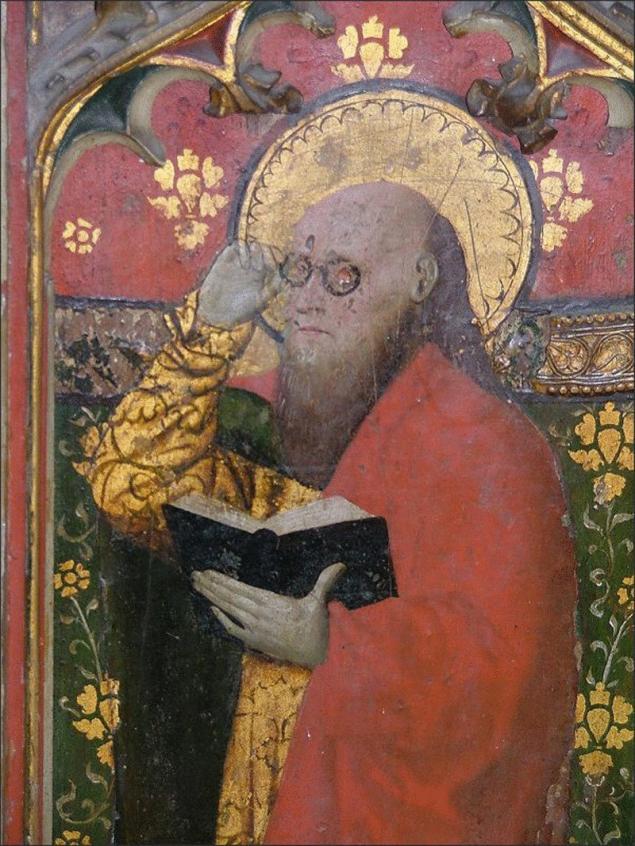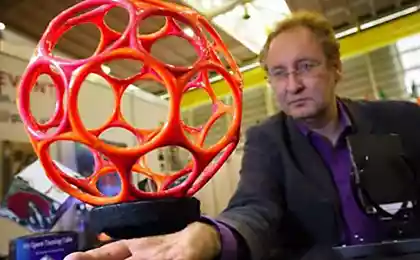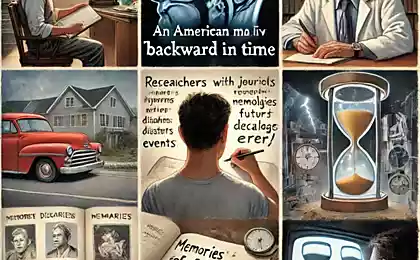467
5 inventions that existed long before their popularization
If you look at the timeline of scientific progress, we can see that almost all the inventions which make our daily life a full, crammed on a tiny segment at the end. However, some things existed long before those times when they how you think, was invented. T&P to translate the text telling of the ancient versions of modern inventions.

The guns that were used even medieval demons
In the lower right corner image depicts a demon with a gun, and right on the imaginary line of its trunk is here polyusi face shot angel. This woodcut of the XV century from the book of Aurelius Augustine "city Of God" (De Civitate Dei).
The first prototypes of firearms in the war dates back to the 904 year and was made in China. It turns out that people were shooting each other even before the Western calendar has become a four. Chinese artists liked to hide in his work of demons, armed with revolvers — such as seeking to shoot the halo of the Buddha and the demon with the image of the X century.
No one really knows, as the technology of firearms found their way to the West from China, but we know that from the XIV century, this weapon was well known throughout Europe.
But why old portraits of the knights don't look like album covers with gangsta rap? Apparently, the use of gunpowder in battle was not particularly effective — that's why firearms co-existed along with other types of weapons for hundreds of years and sought to become a leader in efficiency. Points were distributed at least from the XIII century
The creation of bifocal glasses is credited, typically, Benjamin Franklin, but it turns out that regular points existed at the time of the invention of the bifocal for four centuries.
On the picture we see proof that or glasses existed in the middle Ages, or Benjamin Franklin was a time traveler. One of the earliest references to the use of spectacles with corrective lenses to improve vision is the theory of the English monk Roger bacon described in his Opus Majus in 1266. And, although it is not clear whether bacon moved their ideas from the pages of paper in the real world, it is absolutely certain that Alessandro di Spina (monk of Pisa) did it. In 1305, Giordano da Rivalto, another monk of Pisa, praised glasses, invented by Alessandro, as he said, "a little less than 20 years ago."
Glasses did a slow path from the West to the far East. The inventors of the XVI century improved the design, adding to the lenses a rope with a loop so you can attach them behind the ears, firmly hold the glasses on your face. They did wear glasses the likeness of a blimp pilot, which forever stick fans of steampunk. The first device with a touchscreen from the 60s
There were times when the interaction with the electronic device using a touch of magic and wizardry of the sensor has been the subject of science fiction. It was in the fifties. However, a scientist named E. A. Johnson from the Royal society the creation of radar stations of great Britain became a pioneer in the creation of the first capacitive touchscreen in an era when people instead of using the remote control, shouting at their children as long as they do not fit to the TV and not switch the channel.
Johnson improved his touchscreen between 1965 and 1967, and in 1968 he published full details of its technologies for use in aviation. It was not just a theory or a one — off prototype air traffic controllers in the UK it used the touchscreen up until 1995. In 1972 was invented by a PLATO IV terminal, allowing to meet the students of the University of Illinois tests with sensor technology — and, perhaps, to play solitaire, if the lectures were boring. Cosmetic rhinoplasty existed a century ago
For the sake of popularity of the Hollywood stars often go under the knife and change their appearance. But this practice has been widespread since the nineteenth century. The demand for nose blew up Europe in the nineteenth century, it is no coincidence that cosmetic surgery was very popular among Jewish businessmen.
To explain this phenomenon, we need to carefully delve into the cultural context of the time: recent ideals of the Enlightenment said that all people have equal statutory rights. This thesis was accompanied by the French revolution, in which mass slightly tweaked face to the ruling class. After that, the Jewish intellectuals were inspired by on our own human rights movement, Jewish emancipation. It meant that all the historical restrictions imposed on Jewish citizens throughout Europe, was to start slowly to go.
Previously, the Jews were excluded from owning land and confined to living in ghettos, they were forbidden to work in most jobs now they could become full members of society. Jewish men pestered the firms in the search for exclusive jobs, but in vain: the reform did not exclude cases of ordinary racism. Because they quickly realized that the job prospects would have looked much better if they looked like all the other employees. And they were right. Colour photography was invented in the 1860s
Black and white media dominated for so long that some avid fans of vintage TV still dreaming to watch programs in monochrome mode. The technology was so perfect, that until recently, people could not conceive that the colors will capture the virtual world. However, not everyone knows that the first color photograph appeared not so recently. It was made by James Maxwell in 1861. This is not one of the "painted" black and white photos. "Tartan ribbon" Maxwell is the first ever made colour photograph, shot with green, red and blue filters and projected onto a single image through the negatives through three filters.
Twenty years later, studying the phenomenon of interference of light, the Frenchman Gabriel Lippmann received the Nobel prize in physics for these photos below. Obviously, "qualitative composition" and "interesting photos" in the 1900s had not yet been invented.
In the XX century photographer Sergei Mikhailovich Prokudin-Gorsky was out on a photographic tour of the Russian Empire at the behest of Tsar Nicholas II. Prokudin-Gorsky used the advanced technology of tri-color filters of Maxwell, and it helped him just to get great quality photographs. published
Source: theoryandpractice.ru

The guns that were used even medieval demons
In the lower right corner image depicts a demon with a gun, and right on the imaginary line of its trunk is here polyusi face shot angel. This woodcut of the XV century from the book of Aurelius Augustine "city Of God" (De Civitate Dei).
The first prototypes of firearms in the war dates back to the 904 year and was made in China. It turns out that people were shooting each other even before the Western calendar has become a four. Chinese artists liked to hide in his work of demons, armed with revolvers — such as seeking to shoot the halo of the Buddha and the demon with the image of the X century.
No one really knows, as the technology of firearms found their way to the West from China, but we know that from the XIV century, this weapon was well known throughout Europe.
But why old portraits of the knights don't look like album covers with gangsta rap? Apparently, the use of gunpowder in battle was not particularly effective — that's why firearms co-existed along with other types of weapons for hundreds of years and sought to become a leader in efficiency. Points were distributed at least from the XIII century
The creation of bifocal glasses is credited, typically, Benjamin Franklin, but it turns out that regular points existed at the time of the invention of the bifocal for four centuries.
On the picture we see proof that or glasses existed in the middle Ages, or Benjamin Franklin was a time traveler. One of the earliest references to the use of spectacles with corrective lenses to improve vision is the theory of the English monk Roger bacon described in his Opus Majus in 1266. And, although it is not clear whether bacon moved their ideas from the pages of paper in the real world, it is absolutely certain that Alessandro di Spina (monk of Pisa) did it. In 1305, Giordano da Rivalto, another monk of Pisa, praised glasses, invented by Alessandro, as he said, "a little less than 20 years ago."
Glasses did a slow path from the West to the far East. The inventors of the XVI century improved the design, adding to the lenses a rope with a loop so you can attach them behind the ears, firmly hold the glasses on your face. They did wear glasses the likeness of a blimp pilot, which forever stick fans of steampunk. The first device with a touchscreen from the 60s
There were times when the interaction with the electronic device using a touch of magic and wizardry of the sensor has been the subject of science fiction. It was in the fifties. However, a scientist named E. A. Johnson from the Royal society the creation of radar stations of great Britain became a pioneer in the creation of the first capacitive touchscreen in an era when people instead of using the remote control, shouting at their children as long as they do not fit to the TV and not switch the channel.
Johnson improved his touchscreen between 1965 and 1967, and in 1968 he published full details of its technologies for use in aviation. It was not just a theory or a one — off prototype air traffic controllers in the UK it used the touchscreen up until 1995. In 1972 was invented by a PLATO IV terminal, allowing to meet the students of the University of Illinois tests with sensor technology — and, perhaps, to play solitaire, if the lectures were boring. Cosmetic rhinoplasty existed a century ago
For the sake of popularity of the Hollywood stars often go under the knife and change their appearance. But this practice has been widespread since the nineteenth century. The demand for nose blew up Europe in the nineteenth century, it is no coincidence that cosmetic surgery was very popular among Jewish businessmen.
To explain this phenomenon, we need to carefully delve into the cultural context of the time: recent ideals of the Enlightenment said that all people have equal statutory rights. This thesis was accompanied by the French revolution, in which mass slightly tweaked face to the ruling class. After that, the Jewish intellectuals were inspired by on our own human rights movement, Jewish emancipation. It meant that all the historical restrictions imposed on Jewish citizens throughout Europe, was to start slowly to go.
Previously, the Jews were excluded from owning land and confined to living in ghettos, they were forbidden to work in most jobs now they could become full members of society. Jewish men pestered the firms in the search for exclusive jobs, but in vain: the reform did not exclude cases of ordinary racism. Because they quickly realized that the job prospects would have looked much better if they looked like all the other employees. And they were right. Colour photography was invented in the 1860s
Black and white media dominated for so long that some avid fans of vintage TV still dreaming to watch programs in monochrome mode. The technology was so perfect, that until recently, people could not conceive that the colors will capture the virtual world. However, not everyone knows that the first color photograph appeared not so recently. It was made by James Maxwell in 1861. This is not one of the "painted" black and white photos. "Tartan ribbon" Maxwell is the first ever made colour photograph, shot with green, red and blue filters and projected onto a single image through the negatives through three filters.
Twenty years later, studying the phenomenon of interference of light, the Frenchman Gabriel Lippmann received the Nobel prize in physics for these photos below. Obviously, "qualitative composition" and "interesting photos" in the 1900s had not yet been invented.
In the XX century photographer Sergei Mikhailovich Prokudin-Gorsky was out on a photographic tour of the Russian Empire at the behest of Tsar Nicholas II. Prokudin-Gorsky used the advanced technology of tri-color filters of Maxwell, and it helped him just to get great quality photographs. published
Source: theoryandpractice.ru






















